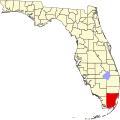El Portal, Florida | |
|---|---|
| Village of El Portal | |
 Typical street in El Portal | |
 Location in Miami-Dade County and the state of Florida | |
 U.S. Census Bureau map showing village boundaries | |
| Coordinates: 25°51′18.62″N80°11′39.01″W / 25.8551722°N 80.1941694°W | |
| Country | |
| State | |
| County | |
| Incorporated | December 6, 1937 |
| Government | |
| • Type | Council–Manager |
| • Mayor | Omarr C. Nickerson |
| • Vice Mayor | Luis Pirela |
| • Councilpersons | Dr. Anna E. Lightfoot-Ward, Darian Martin, and, Anders Urbom |
| • Village Manager | Christia E. Alou |
| • Village Clerk | Yenise Jacobi |
| Area | |
• Total | 0.42 sq mi (1.09 km2) |
| • Land | 0.42 sq mi (1.08 km2) |
| • Water | 0.01 sq mi (0.01 km2) |
| Elevation | 7 ft (2 m) |
| Population | |
• Total | 1,986 |
| • Density | 4,774.04/sq mi (1,844.35/km2) |
| Time zone | UTC-5 (EST) |
| • Summer (DST) | UTC-4 (EDT) |
| ZIP Codes | 33138, 33150 |
| Area codes | 305, 786, 645 |
| FIPS code | 12-20650 [3] |
| GNIS feature ID | 0282132 [4] |
| Website | www |
El Portal is a village in Miami-Dade County, Florida, United States. The name is derived from the Spanish term for "the gate", after two wooden gates that once stood as a gateway to the village. El Portal was originally annexed into the city of Miami in 1925. [5] With the arrival of the Great Depression, Miami gave up its jurisdiction, and El Portal was incorporated as its own village in 1937. [5] The village is part of the Miami metropolitan area of South Florida. As of the 2020 census, the population of El Portal was 1,986, [2] down from 2,325 in 2010.


